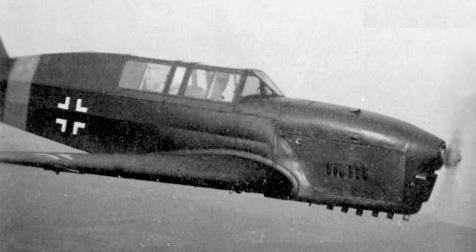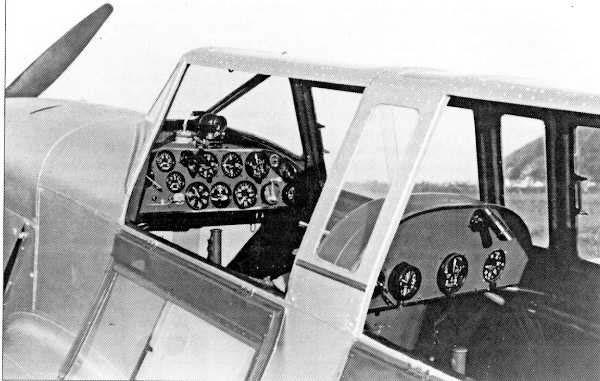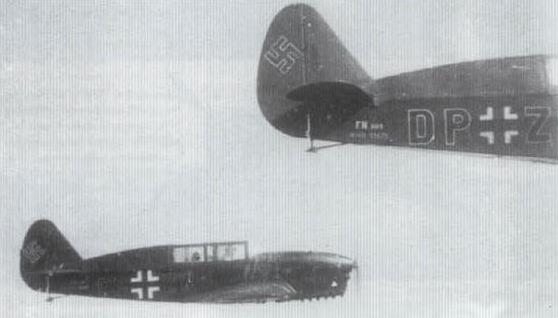| Type |
2-seat fighter trainer |
| Engine |
: 1 Alfa Romeo 115 |
| Dimensions |
Length 6,98 m , height 2,10 m , span 8,47 m , wing area 12 m2 , |
| Weights |
Empty 704 kg, loaded 984 kg , max. take off weight |
| Performance |
Max.. speed 300 km/h, cruising speed , range 620 km, endurance , service ceiling 6000 m , climb |
The Nardi FN.305 was an Italian fighter trainer and liaison monoplane developed by the Fratelli Nardi company.
The FN.305 was designed as trainer and liaison aircraft and the prototype first flew on 19 January 1935. The FN.305 was a low-wing cantilever monoplane of mixed construction. It had tailskid landing gear, with the main gear retracting inwards. It was powered by a nose-mounted 200 hp (149 kW) Fiat A.70S inline piston engine. The prototype was a tandem two-seater with an enclosed cockpit. It was intended to produce both single-seat and two-seat variants and the next prototype was a single-seat fighter trainer followed by a two-seat basic trainer prototype which both had open cockpits. Two long-range FN.305D variants were then produced powered by a 200 hp (149 kW) Walter Bora radial engine. The first FN.305D was a two-seater which was used on a record breaking flight between Rome and Addis Ababa in March 1939 gaining a class record for covering the 4463.8 km at an average speed of 240 km/h . The second FN.305D was a single-seat bought by Yugoslavia for an aborted attempt at a non-stop North Atlantic flight.
The prototype was re-engined with an Alfa Romeo 115 engine as the FN.305A which then entered production by Piaggio as the Nardi works were not large enough. The Italian Air Force had ordered 258 aircraft most of them two-seat FN.305A fighter trainers and liaison aircraft, a few of the aircraft were completed as single-seat open-cockpit FN.305Cs and enclosed-cockpit FN.305Ds. Following the Italian order in 1938 nine aircraft were sold to Chile and 31 to Romania. Romania then built 124 aircraft under licence by IAR. The largest export order came from France but only 41 had been delivered when Italy declared war on France in June 1940. The final export customer was Hungary who ordered 50.
An improved version was developed as the Nardi FN.315.
Founded in Milan by the brothers Euste, Elio and Luigi Nardi, the partnership "Fratelli Nardi" built its first aircraft in 1934-5. The prototype Nardi F.N.305, serial MM277, made its maiden flight on 19 February 1935, piloted by Arturo Ferrarin. A cantilever low-wing monoplane of mixed construction, with inward retracting main landing gear legs, it was intended for intermediate training, sport or touring, and was to become available in both single and two-seat versions. Prototype MM277 was a two-seater with an enclosed canopy over the cockpit and, powered by a 200 hp (149 kW) Fiat A.70S radial engine, attained a maximum speed of 211 mph (340 km/h). Two more prototypes followed, also powered by the Fiat radial, comprising a single-seat fighter trainer and a two-seat basic trainer, both with open cockpits. Two long-range F.N.305D variants were then built, each powered by a 200 hp (149 kW) Walter Bora radial engine. The first (I-UEBI) was a two-seater which made a remarkable non-stop flight from Rome to Addis Ababa, Ethiopia, in March 1939, gaining a record for aircraft in its class and covering 2,773.68 miles (4463.80 km) at an average speed of 149 mph (240 km/h). The second machine, the F.N.30SD II, was a single-seat aircraft bought by Yugoslavia for an abortive non-stop North Atlantic flight. Finally, a prototype was tested with an Alfa-Romeo 115 engine, and it was this F.N.305A version which was put into production at the Piaggio works, the Nardi workshops not being large enough for the task.
To meet Italian air ministry orders a total of 258 series F.N.305s were built by Piaggio, nearly all of them two-seat F.N.305A aircraft which were used as fighter trainers and for liaison by the Regia Aeronautica. Small numbers of the single-seat F.N.305B and F.N.305C were included in the total, the former having an open cockpit and the latter an enclosed canopy. Production was concentrated largely between 1937 and 1943, although eight partly-built machines were completed by the Piaggio works in 1948. F.N.305A series aircraft resembled the Alfa-Romeo powered prototype except for a redesigned canopy.
In the period 1937-1940 F.N.305s took part in many contests and rallies for sport and touring aircraft, frequently carrying off the prizes and gaining for the Nardi company much favourable publicity, and as a result, considerable export orders were received. In 1938 Chile acquired nine machines and Romania 31, the latter country then following this up with licence-manufacture by the IAR company at Brasov, which built a total of 124 F.N.305s, the type becoming the standard Romanian basic/intermediate trainer. Romanian-built aircraft were powered by the IAR 6G-1 engine, a licence-built version of the de Havilland Gipsy Six engine. Romania subsequently obtained 21 F.N.305s from the sixth production series, acquired in lieu of a planned purchase of SIAI S.83 transports which had been rejected by the Romanian government. The largest export order, for 300 aircraft, was received from the French authorities, but only 41 had been delivered to the Armée de I'Air when Italy declared war on France in June 1940. Final foreign purchaser was Hungary with a 50 aircraft order.
The nine Chilean aircraft (eight two seaters and one single seater) equipped Group N° 4 of the Chilean Air Force during the middle of 1938 armed with two 7.7 mm (0.303 in) Breda-SAFAT machine-guns. A combination of pilot inexperience and mechanical failure soon saw several accidents involving the Nardi F.N.305 aircraft, some of them fatal. Three aircraft were totally destroyed in accidents. Despite this, the six surviving aircraft continued in service until June 1942, when they were finally withdrawn from service due to the unavailability of spare parts. They were placed in storage until March 1944, when they were scrapped.
Overall, the Nardi was not very popular with its pilots. It was considered underpowered, with old fashioned controls which were heavy to use at low speeds. Unstable in acrobatics and difficult to recover from a stall. A cramped and uncomfortable cabin, that made bailing out an arduous and dangerous process.




Uebungsflugzeug Nardi „F. N.-305".
Die von den vier Brüdern Nardi in Mailand gegründete Firma Nardi liefert für die italienischen Luftstreitkräfte einen freitragenden Tiefdecker für Uebungszwecke und zur
Pilotenausbildung. Die Maschine kann mit Motoren zwischen 180 und 420 PS ausgerüstet werden und weist bei einem Bruchlastvielfachen von 14 ausreichende Festigkeit
für die Durchführung aller Kunstflugfiguren auf. Mit der ersten Maschine wurde im Juli 1936 der Geschwindigkeitsrekord für
zweisitzige Leichtflugzeuge über eine Entfernung von 1000 km gebrochen. Mit einem Motor von 180 PS betrug die Durchschnittsgeschwindigkeit dabei 311 km/h.
Als besonderer Vorteil v/ird bezeichnet, daß die Maschine im Notfall auch mit eingezogenem Fahrv/erk sicher gelandet werden kann, v/obei außer an der Luftschraube
keine v/e-sentlichen Beschä-digurvgen auftreten. Bei den Abnahmeflügen in Quidonia wurde eine derartige Landung auch erfolgreich vorgeführt.
Flügel freitragend, dreiteilig. Trapezform mit abgerundeten Enden, leichte V-Form. Streckung 1:6, bikonvexes Profil. Flügelmittelteil mit dem Rumpf verbunden, zwei aus
Stahlrohren aufgebaute Holme. Anschluß der Außenflügel mit je vier Bolzen. Holme in den Ansatz-teilen aus Sprucegurten und Sperrholzstegen aufgebaut. Beplankung
Sperrholz. Landeklappen an der Hinterkante zwischen Rumpfund Querrudern. Beim Herunterziehen dieser Klappen heben sich automatisch schmale Flächen ab, die
normal enteise den Spalt zwischen Flügel und Klappe abdecken, und geben diesen Spalt frei.
Rumpf in Stahlrohr ausgeführt, Vorderteil mit Leichtmetall, Ende mit Sperrholz und Stoff bedeckt, läuft in senkrechte Schneide aus. Führersitze hintereinander,
Doppelsteuerung. Lange Haube mit guter Sicht, nach hinten in die Kielflosse übergehend. Bei der Ven/endung als Jagdeinsitzer ist der Führerraum entsprechend kürzer
gehalten.
Leitwerk in Holzbau, Höhenflosse im Fluge verstellbar.
Fahn/erk in zwei selbständigen Hälften. Räder mit Mitteldruckbereifung und Bendix-Bremsen in Gabeln gelagert. Jede Gabel sitzt an einem OelStoßdämpfer, der am
Vorderholm angreift, und nach hinten und seitlich innen abgestrebt ist. Das Einziehen erfolgt von Hand, wobei die Uebersetzung beim Hereinkurbeln größer als beim
Herablassen gewählt werden kann. Durch das Schwenken der Räder nach innen rücken diese nahe an den Gesamtschwerpunkt heran und ergeben damit eine
Verringerung des Trägheitsmomentes um die Längsachse, die sich in besserer Wendigkeit auswirkt. Schleifsporn aus Stahlrohr.
Triebwerk: Reihen- oder Sternmotor mit einer Leistung zwischen 180 und 450 PS. Vorzugsweise kommen die Typen Fiat A-70 (ein Siebenzylinder-Sternmotor mit 115
mm Hub und Bohrung, 162 kg Gewicht, 180 PS bei 2100 U/min), Alfa-Romeo 115-1 (sechs Zylinder in Reihe, 190/200 PS) und Piaggio P-V1I C-45 (sieben Zylinder in
Sternform, Hubraum 19,33 1, Vorverdichter mit zwei Drehzahlen, 425 PS am Boden, 450 PS in 1500 und 390 PS in 4500 m Höhe) zum Einbau.
Spannweite 8,47 m, Länge 7 m (mit Sternmotoren 6A in), Höhe 2,10 m, Fläche 12 m2, Leergewicht 560 kg (mit Fiat A-70) bzw. 600 kg (mit Alfa-Romeo) bzw. 808 kg (mit
Piaggio), Fluggewicht 840 (850, 1060) kg. Höchstgeschwindigkeit am Boden 340 (360, 380) km/h, in 4000 m Höhe 305 (310,405) km/h, Landegeschw. 90—105 km/h,
Steigzeit auf 4000 m 13 (10,5, 7,5) Min., Gipfelhöhe praktisch 7000 (7000, 9000) m, Reichv/eite 900—1000 km, mit Piaggio 1 Std. Flugdauer, Startstrecke 180 (150,160)
m, Auslauf 210 (210, 250) m.
Für militärische Verwendung erhält die Maschine bei Einbau eines schwächeren Motors ein, bei stärkerem Motor zwei MG.
| Type |
Werk.Nr |
Registration |
History |
|
|
BI+JW |
|
|
|
DP+ZV |
FFS A14 |
|
|
DP+ZW |
FFS A14 |
|
|
DP+ZX |
FFS A14 |
|
|
DP+ZZ |
|




